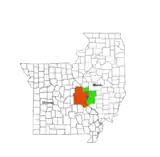Overland, Missouri
Overland is a city in St. Louis County, Missouri, United States. The population was 16,062 at the 2010 census.[6]
Overland, Missouri | |
|---|---|
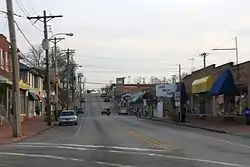 Downtown Overland | |
 Location of Overland, Missouri | |
| Coordinates: 38°41′57″N 90°22′4″W | |
| Country | United States |
| State | Missouri |
| County | St. Louis |
| Area | |
| • Total | 4.41 sq mi (11.41 km2) |
| • Land | 4.39 sq mi (11.37 km2) |
| • Water | 0.02 sq mi (0.04 km2) |
| Elevation | 640 ft (195 m) |
| Population | |
| • Total | 16,062 |
| • Estimate (2019)[3] | 15,551 |
| • Density | 3,543.18/sq mi (1,368.13/km2) |
| Time zone | UTC-6 (Central (CST)) |
| • Summer (DST) | UTC-5 (CDT) |
| FIPS code | 29-55550[4] |
| GNIS feature ID | 0756489[5] |
| Website | www.overlandmo.org |
Geography
Overland is located at 38°41′57″N 90°22′4″W (38.699051, -90.367797).[7]
According to the United States Census Bureau, the city has a total area of 4.38 square miles (11.34 km2), of which 4.36 square miles (11.29 km2) is land and 0.02 square miles (0.05 km2) is water.[8]
Demographics
| Historical population | |||
|---|---|---|---|
| Census | Pop. | %± | |
| 1940 | 2,934 | — | |
| 1950 | 11,566 | 294.2% | |
| 1960 | 22,763 | 96.8% | |
| 1970 | 24,819 | 9.0% | |
| 1980 | 19,620 | −20.9% | |
| 1990 | 17,987 | −8.3% | |
| 2000 | 16,838 | −6.4% | |
| 2010 | 16,062 | −4.6% | |
| 2019 (est.) | 15,551 | [3] | −3.2% |
| U.S. Decennial Census[9] | |||
2010 census
As of the census[2] of 2010, there were 16,062 people, 6,717 households, and 4,136 families living in the city. The population density was 3,683.9 inhabitants per square mile (1,422.4/km2). There were 7,356 housing units at an average density of 1,687.2 per square mile (651.4/km2). The racial makeup of the city was 73.3% White, 16.4% African American, 0.3% Native American, 3.2% Asian, 3.9% from other races, and 3.0% from two or more races. Hispanic or Latino of any race were 6.4% of the population.
There were 6,717 households, of which 30.2% had children under the age of eighteen living with them, 37.5% were married couples living together, 17.7% had a female householder with no husband present, 6.3% had a male householder with no wife present, and 38.4% were non-families. 30.8% of all households were made up of individuals, and 9.6% had someone living alone who was 65 years of age or older. The average household size was 2.38 and the average family size was 2.96.
The median age in the city was 37.9 years. 22.4% of residents were under the age of eighteen; 8.7% were between the ages of eighteen and 24; 28% were from 25 to 44; 28.3% were from 45 to 64; and 12.7% were 65 years of age or older. The gender makeup of the city was 49.0% male and 51.0% female.
2000 census
As of the census[4] of 2000, there were 16,838 people, 7,012 households, and 4,494 families living in the city. The population density was 3,842.8 people per square mile (1,484.3/km2). There were 7,446 housing units at an average density of 1,699.3 per square mile (656.4/km2). The racial makeup of the city was 83.56% White, 11.19% African American, 0.32% Native American, 2.01% Asian, 0.03% Pacific Islander, 0.83% from other races, and 2.05% from two or more races. Hispanic or Latino of any race were 2.19% of the population.
There were 7,012 households, out of which 29.7% had children under the age of 18 living with them, 42.8% were married couples living together, 16.4% had a female householder with no husband present, and 35.9% were non-families. 29.7% of all households were made up of individuals, and 11.6% had someone living alone who was 65 years of age or older. The average household size was 2.40 and the average family size was 2.96.
In the city, the population was spread out, with 24.7% under the age of 18, 8.3% from 18 to 24, 30.9% from 25 to 44, 21.0% from 45 to 64, and 15.1% who were 65 years of age or older. The median age was 37 years. For every 100 females, there were 91.6 males. For every 100 females age 18 and over, there were 89.2 males.
The median income for a household in the city was $34,437, and the median income for a family was $43,655. Males had a median income of $31,168 versus $25,352 for females. The per capita income for the city was $18,266. About 6.6% of families and 9.7% of the population were below the poverty line, including 13.8% of those under age 18 and 3.6% of those age 65 or over.
History
The area south of the King's Road to St. Charles[10] was first settled in the early 1820s, when travelers westward from St. Louis would stop overnight at what became known as "The Overland Park". Daniel Boone, noted frontiersman, constructed a single room cabin here, near the current location of Lake Sherwood and Wyland Elementary School. A historic marker on Wabaday Avenue shows the exact spot.
In time, businesses were established and a one-room subscription school, the Buck School, was built in 1846. In 1867, the Ritenour School District[11] was organized. In 1919, the town's name was shortened to "Overland", to avoid postal confusion with the city of Overland Park, Kansas.
The town was incorporated as a fourth class city in 1939 with a mayoral-city council government. In the 1990s, the city voters approved a change to a third class city. In 2007, the city voted to move to a mayor-council-administrator form of government. Under this structure, the mayor serves as the chief elected official. The city council serves as the legislative body, and is empowered to pass ordinances and resolutions it deems necessary to the operation of the city. The city administrator is a full-time employee of the city, and executes the day-to-day tasks of operations.[12]
Notable locations
The historic "Overland Park" wagon train stop is located near the intersection of Midland Boulevard and Lackland Road. A monument marks this site.
An early Overland settler and prominent St. Louis businessman, Dennis Lackland, built the Lackland House in 1844 on the road later named for him. The nearby McElhinney Log House, built in the 1850s, is maintained by the Overland Historical Society.
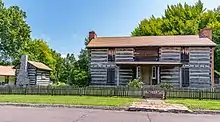
The Ritenour School, built in 1867 on Woodson Road, was remodeled and expanded over the years and is currently the Ritenour School District's administration building.
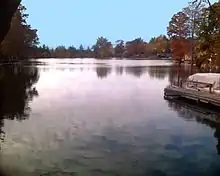
Lake Sherwood (originally Lake Laughlin or Loch Lin), which is near the original Overland Park, was developed as a private residence in 1877 and is now a gated community. The lake is spring-fed, and the dam spills into headwaters for the River des Peres.[13] Construction of the earthen dam was completed in 1894. Its height is 21 feet (6.4 m), capacity is 135 acre feet (167,000 m3), and normal storage is 80 acre feet (99,000 m3). It drains an area of 121 square miles (310 km2). At normal levels, the lake has a surface area of 12 acres (49,000 m2). The lake is owned by the Lake Sherwood homeowners' association and is used for recreational purposes.
The Gocke-Vance House, on Poe Avenue, was built in 1910 by Edward Gocke. This fireproof house was built from plans drawn by Frank Lloyd Wright.[14]
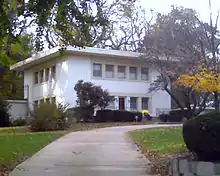
Overland has several large parks. The Garnett Estate, built in 1907 on Ashby Road, is now owned and maintained by the city as Wild Acres Park; it is a secluded area, offering walking paths and a small fishing lake. Mort Jacobs Park is a rolling acreage of tall trees and hiking paths. Norman Myers Park (formerly Taylor Field) is a large athletic field with a one-third-mile running track and adjacent picnic areas. It is home to Overland's annual Lion's Fair. Other smaller parks dot the city, providing family outing opportunities.
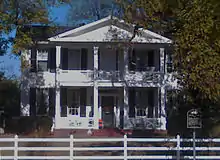
Economy
Build-A-Bear Workshop is headquartered in Overland,[15] and concentrate manufacturing operations for Dr Pepper Snapple Group[16] are located in Overland. Overland is less than five miles from the St. Louis Boeing plant, Monsanto and Emerson Electric, where many Overland residents are employed. Overland supports a healthy and prosperous retail district.
Overland was the location of the National Personnel Records Center, which houses discharged and retired service records of all branches of the United States armed forces. The city was also the location of the Army Human Resources Command (HRC), prior to the facility's closing as a result of the military's 2005 Base Realignment and Closure process. The former Army HRC building is now called the Charles F. Prevedel Federal Building and is home to offices of the Department of Veterans Affairs and Department of Agriculture.
Education
The Ritenour School District serves the city.[17] Ritenour High School serves the city.
Notable people
Charles A. Lindbergh once lived in what was at the time the northeast edge of Overland, the Home Heights area. In October 1920, he took a series of aerial photos of the Overland area.[18][19]
The following individuals grew up in the Overland area and graduated from Ritenour High School in Overland:[20]
- Maj. Gen. James L. Day, USMC, Medal of Honor recipient
- Ron Hunt, major league baseball second baseman
- Mike Keefe, editorial cartoonist for The Denver Post
- Ted Kulongoski, Governor of Oregon 2003-2011
- Gene Louis, drummer and lead singer of Bullets and Octane
- Dan Marsala, lead singer of Story of the Year
- Jerry Reuss, major league baseball pitcher and broadcaster
- Bob Scheffing, major league baseball catcher, manager of Detroit Tigers and Chicago Cubs, general manager of New York Mets
- Dave Spence, businessman and Republican nominee for Governor of Missouri in 2012
- Bob Todd, retired head baseball coach at Ohio State University
- Billie Lou Watt, stage and television actress
Mayoral controversy
On April 3, 2007, Overland residents voted to recall Mayor Ann Purzner, who had been accused of lying about her career credentials and exceeding her power as mayor. She was temporarily replaced by Alderman Jerry May, and in the August 2007 election, Councilman Mike Schneider was elected mayor.[21]
References
- "2019 U.S. Gazetteer Files". United States Census Bureau. Retrieved July 26, 2020.
- "U.S. Census website". United States Census Bureau. Retrieved 2012-07-08.
- "Population and Housing Unit Estimates". United States Census Bureau. May 24, 2020. Retrieved May 27, 2020.
- "U.S. Census website". United States Census Bureau. Retrieved 2008-01-31.
- "US Board on Geographic Names". United States Geological Survey. 2007-10-25. Retrieved 2008-01-31.
- "Race, Hispanic or Latino, Age, and Housing Occupancy: 2010 Census Redistricting Data (Public Law 94-171) Summary File (QT-PL), Overland city, Missouri". United States Census Bureau. Retrieved October 24, 2011.
- "US Gazetteer files: 2010, 2000, and 1990". United States Census Bureau. 2011-02-12. Retrieved 2011-04-23.
- "US Gazetteer files 2010". United States Census Bureau. Archived from the original on 2012-01-25. Retrieved 2012-07-08.
- "Census of Population and Housing". Census.gov. Retrieved June 4, 2015.
- History of St. Louis and St. John, archived from the original on 2010-01-13, retrieved 2009-12-17
- Williamson, Patricia (1978), Ritenour...Our First 132 Years (PDF), Ritenour Consolidated School District, retrieved 2009-12-17
- City of Overland - Government, retrieved 2009-12-17
- The Origins of the River des Peres, Urban Review STL, retrieved 2009-12-17
- The Gocke-Vance House (PDF), retrieved 2017-04-18
- Sorkin, Michael D. (January 17, 2003), Overland, MO-Based Build-A-Bear Recalls Products because of Choking Hazard, St. Louis Post-Dispatch, retrieved 2009-08-19
- DPSG 2008 Annual Report (PDF), Dr Pepper Snapple Group, p. 30, retrieved 2009-12-17
- "General Information". City of Overland. Retrieved 2019-09-20.
- 1920 Photo of east Overland, retrieved 2009-12-17
- 1920 Photo of east Overland, Lake Sherwood and Sycamore Hills, retrieved 2009-12-17
- Ritenour Alumni Hall of Fame, retrieved 17 September 2010
- Overland Mayoral Controversy

